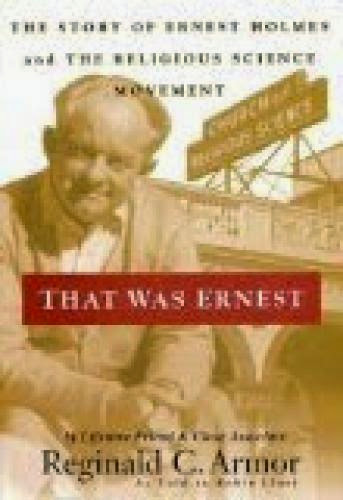There is surprisingly little biographical material about the early figures of the New Thought movement, so I was intrigued to read this eccentric little memoir about Ernest Holmes by his longtime associate and lifelong devotee Reginald C. Armor.Armor was one of Holmes' first and most devoted followers, and one of the first official "practitioners" of Religious Science, the philosophy invented and taught by Ernest Holmes. That Was Ernest is the account of an unusual life spent entirely in the shadow of a great man and a forceful personality, and serves more as a hagiogrphy than serious critical biography.That said, it is a fascinating read, packed with information not just about the beginnings of the Science of Mind movement, but also about Holmes the man, his foibles, vanities and absolute sincerity.Starting life in a dull clerical job in local government, Holmes took advantage of his light duties to read the great spiritual and metaphysical classics in his office, eventually becoming convinced of a unified philosophy that he saw lying behind each of the world's religious systems. He saw God and the Universe in terms of laws and principles which all people had access to, and which they could turn to their advantage (and, it must be stressed, spiritual and moral advancement).By 1935 Religious Science - the movement Holmes had begun to teach these universal spiritual principles - had become phenomenally successful in California, teaching the New Thought philosophies of Emma Curtis Hopkins, Thomas Troward and, of course, Holmes' own unique take on things.Armor tells us that by the 1950s Religious Science had become a huge religious institution, much to the discomfort of Holmes himself, who was uncomfortable with officialdom and dogma, and wanted only to see people educate themselves to make the best possible decisions. Indeed, after the death of his wife Holmes began to explicitly reject the church and its work, returning instead to the closer and older circle of original students who, while less well-trained than the new generation of Ministers that served his church, were more sympatico with the original spirit of the movement.Armor, the book's author, was involved with the Holmes family from childhood, being a parishioner at Ernest's brother Fenwicke's small Congregational Church. Obviously in thrall to this charismatic, clever and religiously obsessive family, Armor quickly became enamoured of the older Ernest, who made himself known by curing Armor of his warts by advising him:"You practice not seeing it. Think of it each day as being gone."Armor's position is surely unique in having known and worked with such an influential figure for such a long period, and through such diverse experiences. It is this incredible insight into the man Holmes that makes this book, as quaint as it may occasionally appear, so fascinating, and such a rich resource for the scholar of twentieth century American religion.


